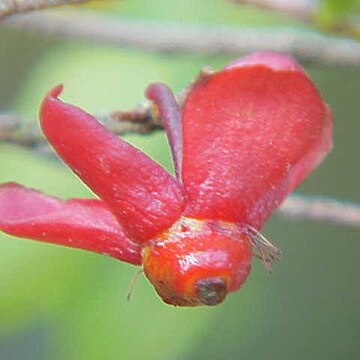Trees, shrubs or geophytic shrublets, less often annual or perennial herbs. Leaves alternate, simple (pinnate and opposite in Rhytidanthera, a small S American genus) often with numerous lateral veins and densely reticulate tertiary venation, entire to serrate or setulose; stipules entire to deeply divided, deciduous or persistent. Flowers hermaphrodite, almost always regular, solitary or in fascicles or raceme-like, paniculate or cymose inflorescences; pedicels often articulated. Sepals (3–4–)5(–6–10), free, usually quincuncially imbricate, persistent or deciduous. Petals (4–)5(–6–12), free, contorted in bud, often clawed, deciduous. Stamens few to many, with persistent filaments; anthers linear, basifixed, dehiscing lengthwise or by apical pores; staminodes present outside stamens in a few genera (>i>Sauvagesia and allies). Ovary superior, sessile, syncarpous, entire to lobed with style and 2–5 parietal placentas each with 1–many ovules, or with (3–)5(–6–15) lobes each with 1 ovule and style gynobasic; styles as many as placentas or ovary-lobes but completely united or free only at the apex with one globose or lobed stigma or separate stigmas. Fruit a collection of 3–12 one-seeded drupelets borne on a fleshy enlarged receptacle, a nut surrounded by unequal enlarged sepals or a septicidal 2–5-valved, 1–many-seeded capsule. Seeds with or without endosperm
Trees or shrubs, rarely herbs, with ±terete branches. Leaves alternate, simple or rarely pinnate, stipulate, mostly glabrous, with midrib prominent on either surface. Inflorescence 1-to many-flowered, cymose, racemose, or thyrsoid, bracteate; lateral, terminal, or both; pedicels articulate. Flowers bisexual, actinomorphic. Sepals 3–10, usually 5, usually persistent, free or a slightly connate at base, often coloured red in fruit. Petals 5 (sometimes to 10), contorted in bud, caducous. Stamens 5–many, free, hypogynous; staminodes sometimes present in 1–3 series; anthers basifixed, dehiscing longitudinally or by apical pores. Ovary superior, 1–15-locular; ovules l–many, axile, or if 1-locular then parietal; style simple; stigmas 1–5, free or ±fused. Fruit a berry or drupelet on an enlarged receptacle. Seeds l–many, small or large, sometimes winged, with or without albumen.
Stamens (1) 5-?, apparently whorled or diplos-temonous or antisepalous, more rarely excentrically grouped, free, inserted on the receptacle; staminodes sometimes present outside the stamens, subulate or petaloid, sometimes connate into a tube; anthers usually ± elongated, extrorse, basifixed, often deciduous, dehiscing by longitudinal slits or apical pores; connective occasionally with a slender prolongation; filaments persistent
Ovary free, sessile, syncarpous, either entire to shallowly lobed with apical style and 2–5 parietal (more rarely axile or basal) placentas each bearing 1-? ovules in two rows, or with (3) 5 (6–15) 1-ovulate lobes and gynobasic style; styles as many as the placentas or ovary-lobes, free towards the apex or completely united
Leaves alternate, simple or very rarely pinnately compound, entire or more often with undulate to serrate or ciliate margins, penninerved (often densely so), membranous to coriaceous, with stipules entire to fringed or ± dissected, free or ± united intrapetiolarly, caducous or ± persistent
Trees, shrubs or shrublets, or more rarely perennial or annual herbs, glabrous or rarely shortly pubescent; bark rough or smooth, sometimes flaking, occasionally pigmented beneath; stem with cortical vascular bundles
Flowers bisexual, actinomorphic or rarely d: zygomorphic, sometimes fragrant, in terminal or axillary paniculate to umbellate or fascicled cymes or in racemes or solitary; pedicels usually articulated
Stamens few to many, free; staminodes sometimes present, subulate or petaloid, sometimes connate into a tube; filaments persistent; anthers linear, basifixed, opening lengthwise or by terminal pores
Sepals (3–4) 5 (6–10), imbricate (usually quincuncial) in bud, free or rarely shortly united at the base, persistent or deciduous, sometimes enlarging in fruit
Fruit either a septicidal 2–5-valved l-?-seeded capsule, or of (3) 4–12 1-seeded drupelets with fleshy or coriaceous mesocarp borne on a ± swollen receptacle
Ovary entire to deeply lobed, 1–10-celled; ovules 1 to many, axile or parietal or attached to the intrusive placentas; style simple or divided at the apex
Seeds exarillate, with or without endosperm; embryo straight or curved, incumbent or accumbent, isocotylous or heterocotylous
Fruiting carpels often becoming quite separate on the enlarged torus and drupaceous, or elongated capsular and septicidal
Leaves alternate, simple, very rarely pinnate, often with numerous pinnate nerves; stipules present, sometimes laciniate
Flowers hermaphrodite, actinomorphic, mostly racemose or paniculate
Seeds 1 to many, with or without endosperm; embryo usually straight
Sepals 4–5, rarely 10, free, imbricate or rarely contorted
Petals (4) 5 (6–12), free, contorted in bud, deciduous
Petals free, 4–10, subsessile, contorted or imbricate
Trees or shrubs with watery juice, rarely herbs

